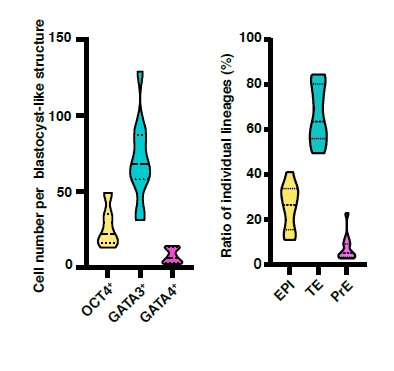
Extremely excited to share our recently published paper in @Nature where we report formation of a faithful in vitro model of human blastocyst. @NRivron lab @IMBA_Vienna
A long tweetorial alert! [1/29]
nature.com/articles/s4158…
A long tweetorial alert! [1/29]
nature.com/articles/s4158…
Right starting cells necessary to form the correct model of blastocyst. We use naive ESCs, cultured in PXGL medium (developed by Austin Smith’s lab), as these are transcriptionally most similar to blastocyst epiblast; have robust potential to form all blastocyst lineages [2/29]
naive hPSC aggregates treated with inhibitors of Hippo, ERK, and TGF-β (trophectoderm formation) and human LIF (epiblast maintenance) along with ROCK inhibitor, rapidly (<96 hours) & efficiently (70-90%) form structures remarkably resembling human blastocysts [3/29]
These blastocyst-like structures effectively form analogs of all the three blastocyst lineages: Trophectoderm, Epiblast and Primitive endoderm (hypoblast) [4/29] 

To evaluate their similarity to human blastocyst, we deeply characterized several features of these blastocyst-like structures. [5/29]
Blastocyst-like structures are morphologically similar to human blastocyst. The size (200 um+/-50), total cell number and ratio of cell numbers of blastocyst lineage analogs were conserved with human Blastocyst. Self-organization processes at play! [6/29] 

Importantly, these structures formed only the three cell-types of the blastocyst lineages: Less than 3% of the cells were ‘off-target’ meaning not reflecting the blastocyst stage. [7/29] 

Projection of single cell transcriptome of these structures on reference map of human embryos, the cells coincided only with blastocyst stage (specifically day 5 to 7 blastocyst), not with post-implantation staged cells of human embryos. [8/29] 

The timing of formation of these structures (< 4days) approximately reflects early to late blastocyst development (days 5-7); the sequence of lineage specification (trophectoderm/epiblast first and primitive endoderm/polar trophectoderm next) followed as in blastocysts [9/29] 

Because of the striking morphology (including cell number and ratios), blastocyst-like transcriptome, and proper developmental sequence/pace, we refer to them as human blastoids. [10/29]
The human blastocyst interacts with the endometrium to implant in utero and pursue development. Human blastoids must not be transferred in utero for any purpose. It is unethical and now forbidden by #ISSCR. See 👇👇 [11/29]
isscr.org/docs/default-s…
isscr.org/docs/default-s…
To test the implantation capacity of human blastoids, we used human endometrial organoids and formed an open faced endometrial layer (OFEL). This facilitated the deposition and live imaging of blastoids to assess their interaction with endometrial cells. [12/29] 

Strikingly, blastoids attach to the endometrial cells only when these are previously stimulated with hormones, but not with the non-stimulated endometrial cells. This mimics the first interaction between blastocyst & uterus [13/29] 

Moreover, similar to blastocyst-uterus interaction, blastoids orientate and position themselves to attach only via the sticky cells on the polar region of trophectoderm (abutting the epiblast). [14/29]
This suggested that the epiblast locally induces the stickiness of polar trophoblasts, endowing them with potential to interact with endometrial cells. [15/29]
Accordingly, by preventing epiblast formation (STAT inhibition, Hippo over-inhibition), blastoids become trophospheres that lack potential to stick to endometrial cells. [16/29] 

Thus, the epiblast induces maturation of polar trophectoderm endowing it with the capacity to attach to stimulated endometrial cells. This creates a window of opportunity for implantation. [17/29]
Using scRNAseq data, we inferred number of ligands-receptor pairs that might mediate the initial attachment between blastocyst and uterus. [18/29]
Blastoids cultured for extended period in post-implantation culture conditions (we have cultured for upto 6 days; time equivalent to day 13 blastocyst) expands all lineages, undergo developmental progression. But doesn’t resemble the equivalent stage morphologically. [19/29] 

Overall, blastoids effectively form and pattern the right cells, in the right sequence and pace, allowing them to model aspects of implantation and post-implantation development. This will allow to dig deep into mechanisms of early human embryogenesis and implantation. [20/29]
Despite similarity to human blastocyst, no evidence exists to suggest that blastoids have organismal potential. In the current state, blastoids must be only used as a scientific tool. Therefore, we strongly believe that the term ‘embryo model’ best describes this system.[21/29]
The alternative terms such as ‘artificial embryos’ or ‘synthetic embryos’ to describe such models is inaccurate and could be misleading in terms of the range of applications of such models. Hence we propose that such terms must be avoided. [22/29]
We believe that blastoids are an ethical opportunity complementary to the use of blastocysts for research. [23/29]
@NRivron (along with several other scientists) has actively participated in the efforts by #ISSCR to develop an ethical framework to work with embryo models, ensuring that blastoids are used within ethical boundaries. [24/29]
This study was possible because of the vision of our supervisor @NRivron and his extraordinary mentorship. Personally, to me this study was the epitome of teamwork and coordination. I truly enjoyed working with other 2 co-first authors @harunobu_kagawa and @HK_Heidar . [25/29]
@NRivron @harunobu_kagawa @HK_Heidar Extremely thankful to @TheresaMSommer , who provided extremely valuable support and performed several important experiments (trophospheres). Giovanni and Maria chipped in at crucial moments to help with all the bioinformatic analysis [26/29]
Grateful to amazing collaborators Gael, @PhD_bruneau from Laurent David lab who along with Thomas Freour and his team performed all the experiments on human blastocysts, and Nina from @HugoVake lab who helped us develop implantation assay. [27/29]
Thankful to all the reviewers for the critical and constructive comments during the revision process. [28/29]
Finally big shout out to @IMBA_Vienna and @VBCF_Tweets for the amazing scientific and work environment and incredible support to carry out this exciting research. [29/29]
And extremely thankful to @YvonneSoR for all the support in the lab with experiment as well as management.
• • •
Missing some Tweet in this thread? You can try to
force a refresh



